
Louisville is a city in Pottawatomie County, Kansas, United States. As of the 2020 census, the population of the city was 131.
The Oregon missionaries were pioneers who settled in the Oregon Country of North America starting in the 1830s dedicated to bringing Christianity to local Native Americans. There had been missionary efforts prior to this, such as those sponsored by the Northwest Company with missionaries from the Church of England starting in 1819. The Foreign Mission movement was already 15 years underway by 1820, but it was difficult to find missionaries willing to go to Oregon, as many wanted to go to the east, to India or China. It was not until the 1830s, when a schoolmaster from Connecticut, Hall Jackson Kelley, created his "American Society for the Settlement of the Oregon Country," that more interest and support for Oregon missionaries grew. Around the same time, four Nez Perce arrived in St. Louis in the fall of 1831, with accounts differencing as to if these travelers were asking for "the book of life", an idea used by Protestant missionaries, or if they asked for "Blackrobes", meaning Jesuits, thus Catholic missionaries. Either way this inspired Christian missionaries to travel to the Oregon Territory. Oregon missionaries played a political role, as well as a religious one, as their missions established US political power in an area in which the Hudson's Bay Company, operating under the British government, maintained a political interest in the Oregon country. Such missionaries had an influential impact on the early settlement of the region, establishing institutions that became the foundation of United States settlement of the Pacific Northwest.
Saint Mary's Academy and College is a religious school of the Society of St. Pius X located in St. Marys, Kansas.
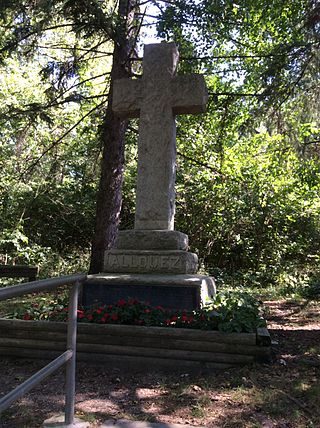
Claude Jean Allouez was a Jesuit missionary and French explorer of North America. He established a number of missions among the indigenous people living near Lake Superior.
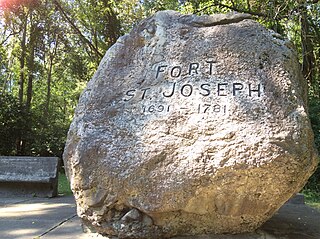
Fort Saint Joseph was a fort established on land granted to the Jesuits by King Louis XIV; it was located on what is now the south side of the present-day town of Niles, Michigan. Père Claude-Jean Allouez established the Mission de Saint-Joseph in the 1680s. Allouez ministered to the local Native Americans, who were primarily Odawa and Ojibwe.

The Archdiocese of Portland in Oregon is a Latin Church archdiocese of the Catholic Church in western Oregon in the United States.
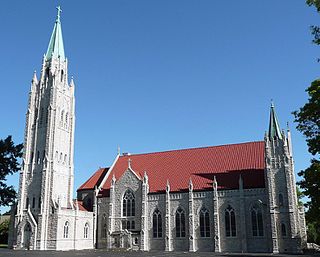
The Archdiocese of Kansas City in Kansas is a Latin Church ecclesiastical province, or archdiocese, of the Catholic Church in eastern Kansas in the United States.

The Potawatomi Trail of Death was the forced removal by militia in 1838 of about 859 members of the Potawatomi nation from Indiana to reservation lands in what is now eastern Kansas.
Benjamin Marie Petit was a Catholic missionary to the Potawatomi at Twin Lakes, Indiana, where he served from November 1837 to September 1838. A native of Rennes in Brittany, France, Petit was trained as a lawyer at the University of Rennes, but left the profession after three years to enter the Saint-Sulpice Seminary in Paris to study for the priesthood. In 1836 he decided to move to the United States to become a missionary among the Native Americans. He traveled to New York with a group led by Bishop Simon Bruté, the first bishop of the Catholic Diocese of Vincennes. Petit was sent to Vincennes, Indiana, where Bishop Bruté ordained him as a Roman Catholic priest on October 14, 1837. Within a month the bishop sent the newly ordained priest to work among the Potawatomi in northern Indiana.
Carey Mission was established in December 1822 by Baptist missionary Isaac McCoy among the Potawatomi tribe of American Indians on the St. Joseph River near Niles, Michigan, United States. It was named for English Baptist missionary William Carey. Its official nature and reputation made it a headquarters for settlers and an edge of the American frontier.

Johnston Lykins was a prominent settler and civic leader in the American frontier Town of Kansas, which became Kansas City, Missouri. He was editor of the first printing press in what became Kansas, and founded the area's first bank, newspaper, and Baptist church. He was the Town of Kansas's first president of city council, and first duly elected mayor. He is reportedly "possibly associated with more Kansas City 'firsts' than any other early settler".
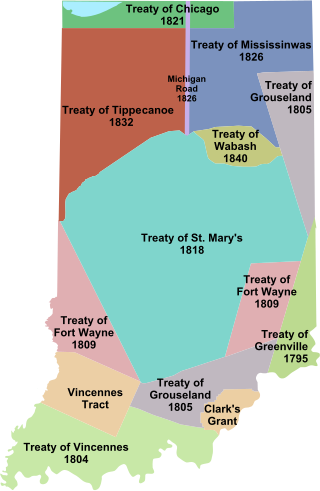
Indian removals in Indiana followed a series of the land cession treaties made between 1795 and 1846 that led to the removal of most of the native tribes from Indiana. Some of the removals occurred prior to 1830, but most took place between 1830 and 1846. The Lenape (Delaware), Piankashaw, Kickapoo, Wea, and Shawnee were removed in the 1820s and 1830s, but the Potawatomi and Miami removals in the 1830s and 1840s were more gradual and incomplete, and not all of Indiana's Native Americans voluntarily left the state. The most well-known resistance effort in Indiana was the forced removal of Chief Menominee and his Yellow River band of Potawatomi in what became known as the Potawatomi Trail of Death in 1838, in which 859 Potawatomi were removed to Kansas and at least forty died on the journey west. The Miami were the last to be removed from Indiana, but tribal leaders delayed the process until 1846. Many of the Miami were permitted to remain on land allotments guaranteed to them under the Treaty of St. Mary's (1818) and subsequent treaties.

The Kansas Historical Society is the official state historical society of Kansas.
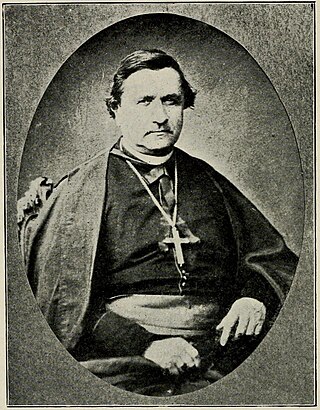
John Baptist Miège, S.J., was a Jesuit prelate and missionary. In addition to a career in education, he served as Vicar Apostolic of Kansas from 1851 to 1874.

Menominee was a Potawatomi chief and religious leader whose village on reservation lands at Twin Lakes, 5 miles (8.0 km) southwest of Plymouth in present-day Marshall County, Indiana, became the gathering place for the Potawatomi who refused to remove from their Indiana reservation lands in 1838. Their primary settlements were at present day Myers Lake and Cook Lake. Although Menominee's name and mark appear on several land cession treaties, including the Treaty of St. Mary's (1818), the Treaty of Mississinewas (1826), the Treaty of Tippecanoe (1832), and a treaty signed on December 16, 1834, he and other Potawatomi refused to take part in subsequent land cession negotiations, including the Treaty of Yellow River (1836), that directly led to the forced removal of Menominee's band from Indiana in 1838.

Pierre-Jean De Smet, SJ, also known as Pieter-Jan De Smet, was a Flemish Catholic priest and member of the Society of Jesus (Jesuits). He is known primarily for his widespread missionary work in the mid-19th century among the Native American peoples, in the midwestern and northwestern United States and western Canada.
Christiaan Jacob Adriaan Hoeken, SJ (1808–1851) was a Jesuit missionary of Dutch origin who worked in the United States among the first nations. He wrote several books in Potawatomi and founded St. Ignatius Mission among the Kalispel. Hoecken died of malaria sailing up the Missouri River.

St. Francis Mission is a Roman Catholic mission complex on the Rosebud Indian Reservation in St. Francis, South Dakota, in territory of the Lakota (Sioux) Native Americans. The mission was founded in 1886 by priests of the Society of Jesus (Jesuits), who were welcomed by Bishop Martin Marty of the Diocese of Saint Cloud, Minnesota, which extended to this territory at the time. The Jesuit order soon developed a large complex to serve the Lakota at this reservation. Most of the buildings were destroyed by a fire in 1916, but many were soon rebuilt.

The St. Peter's Mission Church and Cemetery, also known as St. Peter's Mission and as St. Peter's-By-the-Rock is a historic Roman Catholic mission located on Mission Road 10.5 miles (16.9 km) west-northwest of the town of Cascade, Montana, United States. The historic site consists of a wooden church and "opera house" and a cemetery. Also on the site are the ruins of a stone parochial school for boys, a stone convent, and several outbuildings.
Flandreau Indian School (FIS), previously Flandreau Indian Vocational High School, is a boarding school for Native American children in unincorporated Moody County, South Dakota, adjacent to Flandreau. It is operated by the Bureau of Indian Education (BIE) and is off-reservation.
















